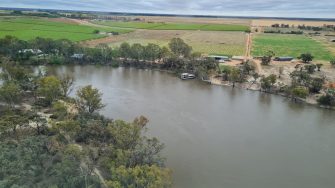
Date: Wednesday, November 10, 2021
Project: Eastern Australian Waterbird Survey
Observers: Richard Kingsford & John Porter
Pilot: Tim Dugan
We decided to get away early because the rain was coming, setting off from Goolwa 7 a.m.
Early morning take-off from Goolwa.
It was back to the Murray River and the Riverland to do our second count of its wetlands. Here on either side there are green irrigation areas.
Bright green irrigation areas along the River Murray.
We retraced our steps surveying the locks and the different lakes as well as the main channel of the River Murray, between the locks.
One of the locks on the River Murray.
There were similar patterns of waterbirds across the different wetlands as when we had surveyed the few days earlier – quite a few ducks and other waterbirds on the wetlands of the Chowilla floodplain but very few birds in the more permanently flooded river channels.
Lake Woolpolool, one of the shallow wetlands with hundreds of waterbirds on the Chowilla floodplain.
We also needed to pick up on a few wetlands out here which are part of our eastern Australian waterbird survey, along Band 3, including an evaporation bay where salty groundwater is pumped out the river, east of Renmark. This often has reasonable numbers of grey teal, black swans and avocets. There were probably a few hundred in total, not quite as numerous as in previous years.
We got into Mildura and refuelled and then headed down to survey of a small section of the main river channel of the Murray which we do each year. It rarely ever has more than a few cormorants and the odd black duck. And today was no different.
Surveying the main channel of the River Murray, east of Mildura.
And then we headed up into the clouds and back to Sydney, going through banks of storms on the way back which bumped us around a bit before arriving back in Bankstown in the pouring rain.
By Richard Kingsford.
